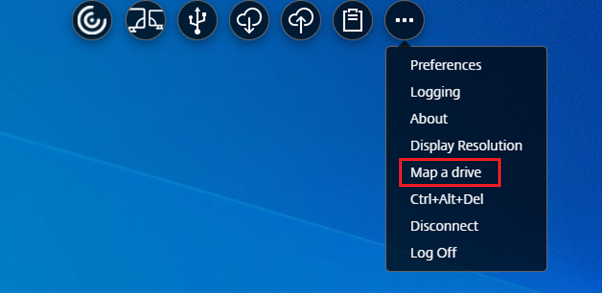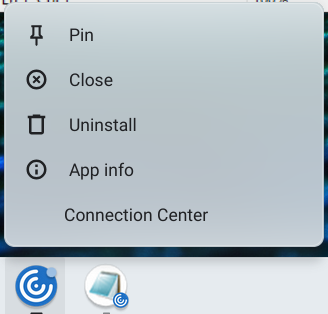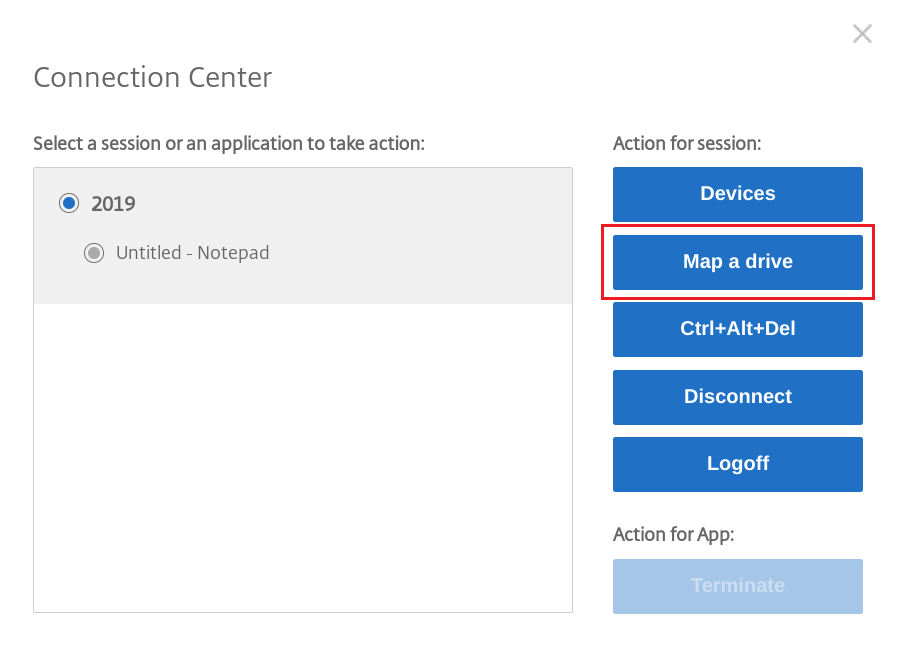File handling
File transfer
Citrix Workspace app for ChromeOS provides secure file transfer between a user device and a session. The session can be of the type Citrix Virtual Apps and Desktops and Citrix DaaS session. This feature uses a file transfer virtual channel instead of client drive mapping.
By default, users can:
- Upload files from a local download folder or attached peripheral
- Seamlessly access data from their Citrix Virtual Apps and Desktops and Citrix DaaS sessions.
- Download files from their Citrix Virtual Apps and Desktops and Citrix DaaS sessions.
- You can download files to a local folder or a peripheral on their user device.
Administrators can configure file transfer, uploads, and downloads using policies in Citrix Studio.
Prerequisites
- XenApp or XenDesktop 7.6 or later, with:
- Hotfix ICATS760WX64022.msp on server OS VDAs (Windows 2008 R2 or Windows 2012 R2)
- Hotfix ICAWS760WX86022.msp or ICAWS760WX64022.msp on client OS VDAs (Windows 7 or Windows 8.1)
- To change file transfer policies: Group Policy Management (GPM) hotfix GPMx240WX64002.msi or GPMx240WX86002.msi on machines running Citrix Studio.
Known limitations in the feature
- A user can upload or download a maximum of 10 files at a time.
- Maximum file size:
- For uploads: 2147483647 bytes (2 GB)
- For downloads: 262144000 bytes (250 MB)
Known issues in the feature
- If either the Upload file to Desktop or the Download file from Desktop policy is set to Disabled, the toolbar still displays both the Upload and the Download icons. However, the functionality is based on the policy setting. If both policies are set to Disabled, the Upload and Download icons aren’t displayed in the toolbar.
Configure file transfer policies
To configure file transfer using a Citrix Studio policy
By default, file transfer is enabled.
Use Citrix Studio to change the following policies, located under User Setting> ICA® > File Redirection.
| Citrix Studio policy | Description |
|---|---|
| Allow file transfer between desktop and client | To enable or disable the file transfer feature |
| Upload file to Desktop | To enable or disable file upload in the session. Requires the “allow file transfer between desktop and client” policy to be set to true. |
| Download file from Desktop | To enable or disable file download from the session. Requires the “allow file transfer between desktop and client” policy to be set to true. |
To configure file transfer using configuration.js file
The configuration.js file is in the ChromeApp root folder. Edit this file directly to modify Citrix Workspace app to suit your requirement.
Notes:
- Citrix recommends that you back up the configuration.js file before making changes.
- Citrix recommends editing the configuration.js file only if the Citrix Workspace app for ChromeOS is repackaged for users.
- Administrator-level credentials are required to edit the configuration.js file. After editing the file, repackage the app to make more modifications to the toolbar elements.
To change the file transfer configuration using the configuration.js file
Open the configuration.js file and configure the settings as follows:
| File Transfer Client Settings | Description |
|---|---|
| AllowUpload | To enable or disable upload from client-side. By default set to true (enabled). |
| AllowDownload | To enable or disable download from the client-side. By default set to true (enabled). |
| MaxUploadSize | To set the maximum size of the file that can be uploaded in bytes. By default set to 2147483648 bytes (2 GB) |
| MaxDownloadSize | To set the maximum size of the file that can be downloaded in bytes. By default set to 2147483648 bytes (2 GB). |
Following are the behavior cases when the policies set in Citrix Studio and the client are different.
| Citrix Studio Policy Upload / Download | Client- side setting Upload / Download | Resulting Behavior |
|---|---|---|
| DISABLED | ENABLED | DISABLED |
| DISABLED | DISABLED | DISABLED |
| ENABLED | DISABLED | DISABLED |
| ENABLED | ENABLED | ENABLED |
Note:
When there’s a conflicting value set for Maximum File Size upload or download in the registry and in the client-side settings, the minimum size value among the two is applied.
To configure file transfer using the Google admin policy
By default, the file transfer feature is enabled.
To disable it, set the enabled attribute to false.
{
"settings": {
"Value": {
"settings_version": "1.0",
"engine_settings": {
"ui": {
"features": {
"filetransfer" : {
"allowupload": true,
"allowdownload": true,
"maxuploadsize": 2147483647,
"maxdownloadsize": 2147483647
}
}
}
}
}
}
}
<!--NeedCopy-->
List of file transfer options with their descriptions:
-
allowupload: Allows you to upload files from device to remote session. -
allowdownload: Allows you to download files from device to remote session. -
maxuploadsize: It is the maximum file size, in bytes that can be uploaded. By default, it is set to 2,147,483,648 bytes (2 GB). -
maxdownloadsize: It is the maximum file size, in bytes that can be downloaded. By default, it is set to 2,147,483,648 bytes (2 GB).
To transfer files to and from Google Drive
You can seamlessly transfer files using File Upload and Download feature. You can transfer files to and from Google Drive and Citrix Virtual Apps and Desktops™ sessions.
Note:
This feature supports only file transfer and not folders.
DDC policy
By default, the file transfer policies are enabled. For more information, see Configure file transfer policies.
How to copy files from Google Drive to a virtual session
Use the file Upload functionality to upload any file from your Google Drive to your session.
To copy files:
-
Click File Transfer > Upload from the toolbar.
The file picker screen with My Files appears.
-
Click Google Drive from the left pane and select the file you want to upload to session.
-
Click Open.
The upload process starts.
-
Select the destination folder within the Citrix session where the file must be saved.
You can view the progress bar within the Citrix session.
Note:
Alternatively, you can also drag the files from Google Drive on client to session window without the need to use toolbar.
How to copy files from a virtual session to Google Drive
Use the file Download functionality to transfer files from your session to Google Drive on the Chromebook. To copy files:
-
Navigate to
chrome://settings/downloadsin your Chromebook. -
Toggle the setting
Ask where to save each file before downloading, to choose the destination path. Alternatively you can change the default Download location to a folder within Google Drive, to automatically download to that folder. -
Click File Transfer > Download from the toolbar.
The file picker screen appears.
-
Select a file that you want to copy to Google Drive.
-
Click Open.
The download process starts. After the download completes, the Files app opens.
-
Select the destination folder within the Google Drive session where the file must be saved.
You can view the progress bar within the Citrix session.
Note:
Alternatively, right-click the file, and select Send to > My device.
Client Drive Mapping
Starting with the 2307 version, the Client Drive Mapping (CDM) feature supports folder mapping on the local ChromeOS device so they’re accessible from within a session. You can map any folder from the ChromeOS device, for example, folders from Downloads, Google Drive, and USB drives, if the folder doesn’t contain system files.
The end user can do the following operations:
- Copy files and folders to the mapped drive from the session and the other way around.
- View the list of files and folders in the mapped drive.
- Open, read, and modify the file contents in the mapped drive.
- View the file properties (modified time and file size only) in the mapped drive.
This feature provides the advantage of accessing both virtual desktop drives and local machine drives together in the file explorer within the HDX™ session.
Known limitations
- You can’t rename files and folders inside the mapped drive.
- Mappings have the name of the folder and not the full path.
- If your local folder has hidden files, and you mapped the same folder, the hidden files are visible inside the session in the mapped drive.
- You can’t change the file property to read-only access in the mapped drive.
- CDM isn’t supported when sessions are opened in Embed mode using HDX SDK.
-
When you map a folder from a removable device and remove the device during an active session, you can’t use that mapped drive inside the session. To remove the mappings manually, click X mark against the particular mapping.

Configure CDM
You can configure the CDM feature in one of the following ways:
- Configuration.js
- Google Admin Policy
Note:
- As a prerequisite, an administrator must enable the Client drive redirection policy on the Delivery Controller (DDC). For more information, see Client Drive Redirection in the Citrix Virtual Apps and Desktops documentation.
Configuration.js
To disable CDM support using the configuration.js file, do the following:
- Locate the configuration.js file in the ChromeApp root folder.
-
Edit the file to configure the CDM feature.
Notes:
- Citrix recommends that you back up the configuration.js file before making changes.
- Citrix recommends editing the configuration.js file only if the Citrix Workspace app for ChromeOS is repackaged for users.
- Administrator-level credentials are required to edit the configuration.js file.
-
Set the value of clientDriveMapping to false.
The following is an example of JSON data:
'features': { 'clientDriveMapping': { 'enabled': false, 'availableAccessLevels': ["Read-write","Read-only,No-access"], 'accessLevel': "Read-write" } } <!--NeedCopy--> - Save the changes.
Google admin policy
For managed devices and users, administrators can disable the CDM feature using the Google Admin Policy as follows:
- Sign in to the Google Admin Policy.
- Go to Device management > Chrome Management > User Settings.
-
Add the following strings to the policy.txt file under the engine_settings.
Note:
You can apply this configuration on the following as well:
- Device > Chrome > Apps and extensions > Kiosks > Search for the extension > Policy for extensions.
- Device > Chrome > Apps and extensions > Managed guest sessions > Search for the extension > Policy for extensions.
The following is an example of JSON data:
{ "settings": { "Value": { "settings_version": "2.0", "engine_settings": { "features": { "clientDriveMapping": { "availableAccessLevels": ["Read-write", "Read-only","No-access"], "accessLevel": "Read-write" } } } } } } <!--NeedCopy--> - Save the changes.
Access level
You can set the folder or drive access levels when the feature is enabled. For example, if an administrator sets availableAccessLevels as [“No-Access”, “Read-only”], the end user can view the Read-Only Access and No-Access options in the drop-down list.
How to use the CDM feature
On desktop sessions:
-
Navigate to the Toolbar > more (…) > Map a drive.

The CDM dialog appears.
-
See How to use CDM UI section for the next steps.
On app and desktop sessions:
-
From the Chrome shelf, right-click the Citrix Workspace app icon and select Connection Center

The Connection Center screen appears.
-
Select the session and the app. Click Map a drive.

The CDM dialog appears.
-
See How to use CDM UI section for the next steps.
How to use CDM UI
-
Select the Access level for the folder or the drive. The drop-down list option that you see depends on the access level set by your organization’s IT administrator for your profile.

- Select a Drive letter and click Browse to navigate to your folder or drive in your Chromebook.
- Click Add.
-
Disconnect and reconnect the session.
The session displays the drive letter that is mapped inside the session.